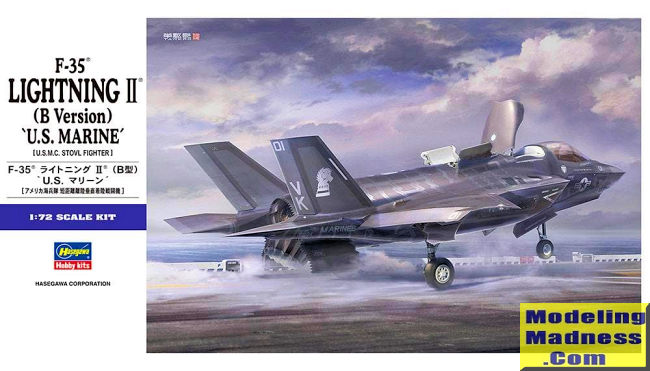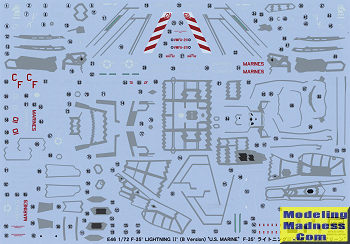
Hasegawa 1/72 F-35B Lightning II
| KIT #: | 01576 |
| PRICE: | 2800 yen |
| DECALS: | Two options |
| REVIEWER: | Tom Cleaver |
| NOTES: | 2018 tooling. Base boxing |

| HISTORY |
The Lockheed Martin F-35 Lightning II is a family of single-seat, single-engine, all-weather stealth multirole fighters. The fifth-generation combat aircraft is designed to perform ground attack and air superiority missions. It has three main models: the F-35A conventional takeoff and landing (CTOL) variant, the F-35B short take-off and vertical-landing (STOVL) variant, and the F-35C carrier-based Catapult Assisted Take-Off But Arrested Recovery (CATOBAR) variant. On 31 July 2015, the United States Marines declared ready for deployment the first squadron of F-35B fighters after intensive testing. On 2 August 2016, the U.S. Air Force declared its first squadron of F-35A fighters combat-ready.
The F-35 descends from the X-35, the winning design of the Joint Strike Fighter (JSF) program. An aerospace industry team led by Lockheed Martin designed and manufactures it. Other major F-35 industry partners include Northrop Grumman, Pratt & Whitney and BAE Systems. The F-35 first flew on 15 December 2006. The United States plans to buy 2,663 aircraft. Its variants are to provide the bulk of the crewed tactical airpower of the U.S. Air Force, Navy and the Marine Corps over the coming decades. Deliveries of the F-35 for the U.S. military are scheduled until 2037 with a projected service life up to 2070.
The United States principally funds the F-35 JSF development, with additional funding from partners. The partner nations are either NATO members or close U.S. allies. The United Kingdom, Italy, Australia, Canada, Norway, Denmark, the Netherlands, and Turkey are part of the active development program; several additional countries have ordered, or are considering ordering, the F-35.
The program is the most expensive military weapons system in history, and has been much criticized inside and outside government, in the U.S. and in allied countries. Critics argue that the plane is "plagued with design flaws", with many blaming the procurement process in which Lockheed was allowed "to design, test, and produce the F-35 all at the same time, instead of… [identifying and fixing] defects before firing up its production line". By 2014, the program was "$163 billion over budget [and] seven years behind schedule". Critics also contend that the program's high sunk costs and political momentum make it "too big to kill".
Unlike other variants, the F-35B has no landing hook. The "STOVL/HOOK" control instead engages conversion between normal and vertical flight. Jet thrust is sent directly downwards during vertical flight. The variant's three-bearing swivel nozzle that directs the full thrust of the engine is moved by a "fueldraulic" actuator using pressurized fuel as the working fluid.
The U.S. Marine Corps plans to purchase 340 F-35B and 80 F-35C models to replace current inventories of both the F/A-18 Hornet (A, B, C and D-models), and the AV-8B Harrier II, in the fighter and attack roles. The Marines plan to use the F-35B from "unimproved surfaces at austere bases" but with "special, high-temperature concrete designed to handle the heat". The USMC declared initial operational capability with about 50 F-35s running interim block 2B software on 31 July 2015. The USAF had considered replacing the A-10 with the F-35B, but will not do so because of the F-35B's inability to generate enough sorties. Thanks to the issues with the aircraft and the slow delivery schedule, the USMC has had to pull older F-18A airframes out of the boneyard and have them brought up to standards so they don't run out of aircraft.
| THE KIT |
 First
thing I did was to look through the sprues to see what was common with the F-35A
kit previewed a few years back. The answer is that only a cockpit sprue, the
clear bits and the stand are the same. All the other sprues appear to have been
tooled just for the B version.
First
thing I did was to look through the sprues to see what was common with the F-35A
kit previewed a few years back. The answer is that only a cockpit sprue, the
clear bits and the stand are the same. All the other sprues appear to have been
tooled just for the B version.
This is not surprising as the fuselage and wings are molded into upper and lower halves with the wings molded into the fuselage. The need for the lift engine openings is undoubtedly why they couldn't use the A toolings, even though it looks like the wing/fuselage dimensions are the same. One thing I really like is that you install interlocking fences into the fuselage halves so that when you put them together, they securely lock into each other.
You are provided with full intake trunking to the first compressor stage of the engine. The exhaust is designed so that it can be rotated from level flight to vertical landing if you so wish. The small cockpit is fairly well done with a pilot figure and decals for instruments. You can also detail the lift engine openings if you choose to model the plane with these doors open. The flaperons (combination flaps and ailerons) can be posed lowered as can be the leading edge slats. Horizontal stabilizers are single piece and can only be glued in the neutral position.
 Landing gear
legs and doors are properly complex, with Hasegawa offering wheels up options if
you want to use the display stand for an in-flight presentation. Considering it
is an attack aircraft, it is surprising that no wing pylons are provided, but
perhaps those have not yet been developed. There are a number of small external
pieces that will need to wait until after the decals are applied before
installing.
Landing gear
legs and doors are properly complex, with Hasegawa offering wheels up options if
you want to use the display stand for an in-flight presentation. Considering it
is an attack aircraft, it is surprising that no wing pylons are provided, but
perhaps those have not yet been developed. There are a number of small external
pieces that will need to wait until after the decals are applied before
installing.
The kit provides markings for two planes. Both are in an overall Neutral Grey with FS 36320 areas. The decal sheet is quite large and provides all the tape that you see on the real deal. It is this tape that needs to be installed before attaching some of the small bits. Markings are provided for two planes. One is the box art plane from VMFA-121 while the other is the commander's plane from VMFA-211. There are notes in the instructions that pertain to one or the other marking option so it would be wise to read the instructions prior to starting this one.
| CONCLUSIONS |
So now Hasegawa has produced the USMC variant of the Lightning II. The only one left is the USN boxing. Those who like this aircraft will find this to be a nice kit and should build up into a super model if the build up on the side of the box is any indication.
| REFERENCES |
https://en.wikipedia.org/wiki/Lockheed_Martin_F-35_Lightning_II
April 2018 Copyright ModelingMadness.com. All rights
reserved. If you would like your product reviewed fairly and fairly quickly, please contact the editor or see other details in the
Note to
Contributors. Back to the Main Page
Back to the Review
Index Page
Back to the Previews Index Page